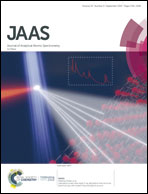Laser ablation-tandem ICP-mass spectrometry (LA-ICP-MS/MS) imaging of iron oxide nanoparticles in Ca-rich gelatin microspheres†
Abstract
This work describes the development of an analytical method for quantitative laser ablation tandem ICP-mass spectrometry (LA-ICP-MS/MS) imaging of iron oxide nanoparticles (FeOx NPs) in gelatin microspheres containing CaCO3 crystals (≤30 μm diameter). The strong spectral overlap between the signal of 56Fe+ and those of 40Ar16O+, 38Ar18O+, 40Ar15NH+ and 40Ca16O+ and between those of 40Ca+ and 40Ar+ was overcome by relying on chemical resolution using a mixture of NH3/He (1 : 9) in a mass-shift approach. Product ion scanning allowed Fe(NH3)2+ and CaNH3+ to be identified as the best suited reaction product ions, formed upon reaction of NH3 with Fe+ and Ca+, respectively. The method was validated by using two certified reference materials, i.e. NIST SRM 1577 and 1577a bovine liver, which were solubilized by acidic digestion. Fe-spiked gelatin droplet standards were prepared on a high-purity single-side polished silicon wafer and used as external calibration standards for LA-ICP-MS/MS analysis and a priori, their corresponding Fe concentrations were determined via pneumatic nebulization tandem ICP-MS (PN-ICP-MS/MS) after acidic digestion. High-resolution LA-ICP-MS/MS imaging revealed the mixed structure of the gelatin microspheres containing a high loading of FeOx NPs (2.69 ± 0.91 wt% Fe) in the gelatin phase. The high FeOx NP concentrations are required for magnetic removal after peritoneal injection and are accompanied by numerous CaCO3 crystals that provide an indication about the final porosity of the microspheres.



 Please wait while we load your content...
Please wait while we load your content...